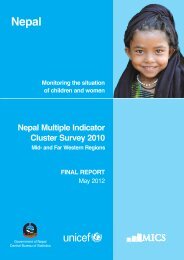6. Conclusions and suggestions for follow-up workIn this exercise <strong>of</strong> small area estimation <strong>of</strong> poverty wehave been able to provide statistically reliable povertymeasures for 2344 areas <strong>of</strong> Nepal by combining theresults <strong>of</strong> NLSS III and Census 2011. When statisticalreliability is doubtful, similar VDCs have beencombined to generate reliable poverty estimates forthe select aggregate <strong>of</strong> VDCs inside a given ilaka. Theestimates are more disaggregated than the ilaka level(967 areas) estimates done in 2006. In addition, for allthe 3972 <strong>of</strong> VDCs / Municipalities considered mostuseful for development purposes confidence intervals<strong>of</strong> poverty estimates are provided.<strong>Poverty</strong> both in proportion and the absolute number<strong>of</strong> poor is high in the hilly areas <strong>of</strong> Far West and parts<strong>of</strong> Mid West. The percentage <strong>of</strong> poor varies fromnegligible in parts <strong>of</strong> Kathmandu to 75 percent in parts<strong>of</strong> Gorkha district. A comparison with the poverty map<strong>of</strong> 2006 shows that though prosperity is spreading inNepal, it has a hard time moving West and climbingHills. <strong>Poverty</strong> concentration in the East and Centralhas declined while it increased in the rest. Nearly halfthe small areas have poverty higher than the nationalaverage <strong>of</strong> 25.2 percent and contain two-thirds <strong>of</strong> thepoor in Nepal.The character <strong>of</strong> the spatial distribution <strong>of</strong> povertyin Nepal is not new but the estimates at 2344 smallareas along with their standard errors should help inbetter design <strong>of</strong> development interventions. While itis straight forward to target development activities inareas with extreme poverty, in areas where povertyis not distinctly different, randomized experimentdesigns can be used to pick appropriate interventionsthat are most effective.The poverty maps could usefully be expanded toother indicators <strong>of</strong> welfare such as nutrition and foodsecurity like in 2006. Detailed spatial distribution <strong>of</strong>poverty <strong>of</strong>fers an opportunity to explore further thecauses <strong>of</strong> poverty trends in Nepal. When combinedwith the spatial distribution <strong>of</strong> correlates <strong>of</strong> povertysuch as access to roads, schools and health facilities,and other variable <strong>of</strong> economic geography, one canfurther our understanding <strong>of</strong> the persistence <strong>of</strong> pockets<strong>of</strong> poverty in Nepal.NEPAL <strong>Small</strong> <strong>Area</strong> <strong>Estimation</strong> <strong>of</strong> <strong>Poverty</strong>, 2011, Summary and Major Findings 15
ReferencesAlderman, H., Babita, M., Demombynes, G., Makhatha, N., and Ozler, B., (2001), “How Low Can You Go?Combining Census and Survey Data for Mapping <strong>Poverty</strong> in South Africa”, Journal <strong>of</strong> African Economies, Vol.11(3).Banerjee, A., Deaton, A. (chair), Lustig, N., and Rog<strong>of</strong>f, K., (2006), “An Evaluation <strong>of</strong> World BankResearch, 1998-2005”. The report can be found at: http://siteresources.worldbank.org/DEC/Resources/84797-1109362238001/726454-1164121166494/RESEARCH-EVALUATION-2006-Main-Report.pdfBedi, T., Coudouel, Al, and Simer, S., (2007), “More than a Pretty Picture: Using <strong>Poverty</strong> Maps to Design BetterPolicies and Interventions.” Washington, DC: World Bank.Central Bureau <strong>of</strong> Statistics (CBS), The World Food Programme (WFP) and The World Bank (WB), (2006), “<strong>Small</strong><strong>Area</strong> <strong>Estimation</strong> <strong>of</strong> <strong>Poverty</strong>, Caloric Intake and Malnutrition in Nepal”. Published by: CBS, WFP and WB;September 2006. ISBN 99933-701-8-5Demombynes, G., Elbers, C., Lanjouw, J.L., and Lanjouw, P., (2006), “How Good a Map: Putting <strong>Small</strong> <strong>Area</strong><strong>Estimation</strong> to the Test”, mimeo, DECRG, the World BankElbers, C., Lanjouw, J., Lanjouw, P., and Leite, P., (2001), “<strong>Poverty</strong> and Inequality in Brazil New Estimates fromCombined PPV-PNAD Data”, mimeo, DECRG, the World Bank.Elbers, C., Lanjouw, J., and Lanjouw, P., (2002), “Micro-Level <strong>Estimation</strong> <strong>of</strong> Welfare”, World Bank Policy ResearchWorking Paper No. WPS 2911Elbers, C., Lanjouw, J., and Lanjouw, P., (2003), “Micro-level <strong>Estimation</strong> <strong>of</strong> <strong>Poverty</strong> and Inequality”, Econometrica,Vol. 71, pp. 355-364.Elbers, C., Lanjouw, P., and Leite, P., (2008), “Brazil within Brazil: Testing the <strong>Poverty</strong> Mapping Methodology inMinas Gerais” , mimeo, DECRG, the World Bank.Ferreira, F., Lanjouw, P., and Neri, M., (2003), “A New <strong>Poverty</strong> Pr<strong>of</strong>ile for Brazil using PPV, PNAD and CensusData”, Revista Brasileira de Economia, Vol. 57(1).Ghosh, M. and Rao, J., (1994), “<strong>Small</strong> <strong>Area</strong> <strong>Estimation</strong>: An Appraisal”, Statistical Science, Vol. 9, pp: 55-93Hasslett, S., and Jones, G., (2005), “Local <strong>Estimation</strong> <strong>of</strong> <strong>Poverty</strong> in the Philippines”, The National StatisticsCoordination Board <strong>of</strong> the Philippines and the World Bank.Lanjouw, P., Marra, M., and Nguyen, C., (2013), “Vietnam’s Evolving <strong>Poverty</strong> Map: Patterns and Implications forPolicy”, World Bank Policy Research Working Paper No. WPS 6355Molina, I, and Rao, J., (2010), “<strong>Small</strong> <strong>Area</strong> <strong>Estimation</strong> <strong>of</strong> <strong>Poverty</strong> Indicators”, Canadian Journal <strong>of</strong> Statistics, Vol.38,pp: 369-385.Nguyen, C., Truoung, T., and Van der Weide, R., (2010), “<strong>Poverty</strong> and Inequality Maps in Rural Vietnam: AnApplication <strong>of</strong> <strong>Small</strong> <strong>Area</strong> <strong>Estimation</strong>”, Asian Economic Journal, Vol. 24(4), pp. 355-390.Rao, J., (2003), “<strong>Small</strong> <strong>Area</strong> <strong>Estimation</strong>”, London: WileyTarozzi, A., and Deaton, A., (2009), “Using Census and Survey Data to Estimate <strong>Poverty</strong> and Inequality for <strong>Small</strong><strong>Area</strong>s”, The Review <strong>of</strong> Economics and Statistics, Vol. 91 (4), pp:773-792.16 NEPAL <strong>Small</strong> <strong>Area</strong> <strong>Estimation</strong> <strong>of</strong> <strong>Poverty</strong>, 2011, Summary and Major Findings
















